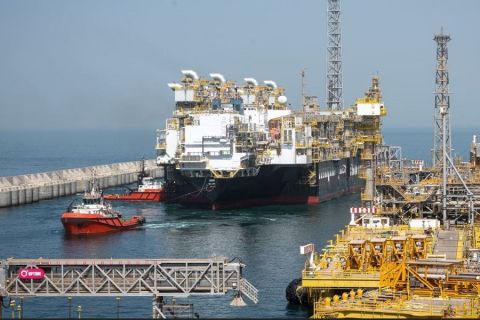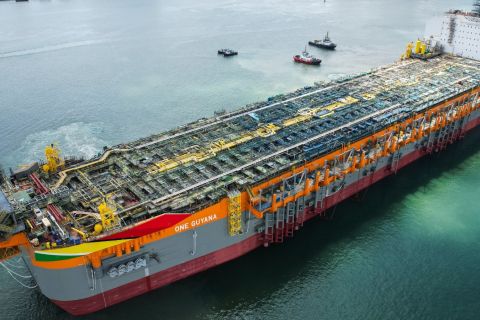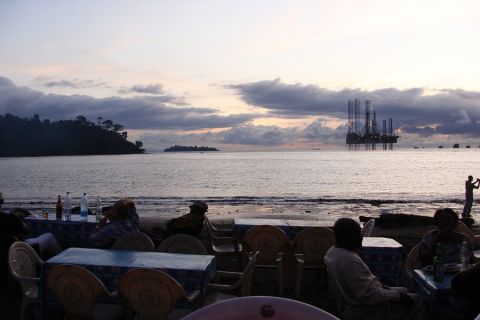With the rapid development of LWD technology, more detailed real-time information allows improved reservoir understanding. The LWD data collection can provide critical measurements for determining the position of subsurface layers and fluid boundaries, which bridge the gap between surface seismic data and near-wellbore petrophysical information.
Ongoing innovation has taken the industry from the first nondirectional LWD methods with minimal depth of investigation capabilities to a new deep-directional resistivity tool that can map bed boundaries more than 30 m (100 ft) from the borehole.
The electromagnetic directional mapping-while-drilling service delineates intrinsic layering of contrasting resistivity and maps multiple reservoir boundaries and fluid layers in real time. As operators shift their focus to new frontiers with reservoirs of increasing complexity, the new reservoir mapping tool service greatly expands the capability to strategically drill and place well trajectories.

FIGURE 1. Possible scenarios were identified on crossing the major fault (pre-job planning phase). (Source: Schlumberger)
The reservoir mapping-while-drilling service provides a more detailed characterization near the wellbore of a reservoir’s ability to produce hydrocarbons. This is possible through the mapping of multiple formation layers at reservoir scale, identifying fluid contacts to determine sweep efficiency and indicating transitions between large sand/shale formations.
Applicable in any well type, the tool consists of multiple subs in the bottomhole assembly that measure resistivity changes along the borehole and map the environment to characterize the reservoir structure at a larger scale. By mapping the reservoir while drilling, the service provides a real-time capability to update reservoir models.
Shell Brazil Petroleo Ltda. used the service with other LWD tools to identify and map the boundaries of a deepwater reservoir to optimally place a horizontal production well. By mapping reservoir boundaries as far as 22 m (72 ft) above and below the wellbore, the service enabled Shell Brazil to more accurately and completely characterize the reservoir and make informed drilling decisions that resulted in significant time and cost savings.
Mapping faulted formation
The well drilled by Shell Brazil was in a deepwater reservoir that targeted a reservoir zone that extended across two fault blocks. The objective was to drill and steer the horizontal production interval from downthrown to upthrown blocks of the fault zone to access reserves on both sides while targeting the reservoir areas with the highest porosity. A pre-job model was built based on conventional seismic and structural data and incorporated petrophysical properties from the surrounding wells.
A small area of the model was updated after a pilot well was drilled in the downthrown fault block. The geological environment of the reservoir is interpreted as unconfined turbidite sands characterized by amalgamated distributory channels with shale zones above and below the reservoir.
The complexity of the reservoir led Shell Brazil to plan for deep electromagnetic directional measurements while drilling, mapping the horizontal well path beginning at the casing shoe just above the downthrown fault block, traversing the block and crossing a normal fault into the upthrown fault block. The primary challenge was to determine the degree of offset along the fault plane in conjunction with the uncertainty of reservoir quality that would be encountered after crossing the fault into the upthrown fault block.
Shell devised three scenarios based on the degree of displacement along the fault plane. The first scenario (A) assumed an accurate interpretation of the seismic map, while the other two scenarios (B and C) assumed a smaller or larger than expected fault throw. Scenarios A and B would require only minor adjustments to place the well path in the most productive zone of the reservoir, while scenario C would require a trajectory change upward to re-enter the reservoir (Figure 1).
Based on those scenarios, the mapping tool would allow Shell Brazil to determine the dip, thickness and resistivity profile of the reservoir in the downthrown fault block; ascertain the relative position of the wellbore to the reservoir upon crossing the fault plane; and map the boundaries of the reservoir geometry and resistivity profile while drilling through the upthrown fault block.

FIGURE 2. Final interpretation of the major reservoir structural and stratigraphic features is shown along with the new interpretation overlaying the seismic section. (Source: Schlumberger)
Assessing reservoir quality
After exiting the casing shoe, the tool mapped the top of the reservoir to be about 4 m (13 ft) above the well path, as expected from the pre-job model. However, the tool detected the base of the reservoir in the downthrown fault block to be roughly 8 m (26 ft) total vertical depth (TVD)—more shallow to the well path than predicted from seismic.
As drilling progressed, real-time interpretation highlighted the quality of the reservoir, which was within expectation in the downthrown fault block. As the well approached the interpreted fault plane, conventional LWD measurements, including laterolog resistivity images, showed no direct indication of the fault or fault zone, while the electromagnetic directional inversion did.
This revealed significant changes in the resistivity profile away from the wellbore as well as a change of structural dip. As the well entered the upthrown fault block, the base of the reservoir was mapped at about 3 m (9.8 ft) TVD below the well path, while the top of the reservoir was mapped at 22 m TVD above the trajectory. This led to the conclusion that the reservoir was similar to scenario C.
As drilling continued, the inversion continuously mapped key features of the base of the reservoir. After crossing the fault, the resistivity profile from the top to the base of the reservoir was shown to be consistently high, a signature of a more highly cemented interval that was later confirmed with mud-logging data while drilling into the upthrown fault block, the top of the reservoir was shallower than pre-job modeling and seismic data had predicted and was at the limit of the tool’s detection capabilities.
When the trajectory passed the cemented zone, the resistivity profile of the formation abruptly lowered and continued to reduce as drilling progressed. This area of the reservoir coincided with the high-amplitude zone of the seismic dataset, which was the primary target in the upthrown fault block. The mapping data identified four layers from top to bottom: a low-resistivity reservoir layer, a conductive and likely shale layer or lens just above the trajectory, the lower resistivity reservoir layer in which the trajectory was being drilled, and the underlying shale below the reservoir (Figure 2).
Using the reservoir mapping-while-drilling information, Shell Brazil decided to lower the trajectory from the original plan to better access the more prolific part of the lower reservoir. As drilling neared the planned total depth of the well, reduced resistivity was detected away from the wellbore as well as at the bit. The decision was made to stop drilling 100 m (328 ft) measured depth short of the plan to avoid unnecessary and costly drilling over a nonproductive interval.
Following the successful operation, Shell Brazil used the service in 15 wells in 2013 and is currently deploying it for 20 more wells in 2014.
Recommended Reading
BP: Gimi FLNG Vessel Arrival Marks GTA Project Milestone
2024-02-15 - The BP-operated Greater Tortue Ahmeyim project on the Mauritania and Senegal maritime border is expected to produce 2.3 million tonnes per annum during it’s initial phase.
Deepwater Roundup 2024: Americas
2024-04-23 - The final part of Hart Energy E&P’s Deepwater Roundup focuses on projects coming online in the Americas from 2023 until the end of the decade.
Deepwater Roundup 2024: Offshore Africa
2024-04-02 - Offshore Africa, new projects are progressing, with a number of high-reserve offshore developments being planned in countries not typically known for deepwater activity, such as Phase 2 of the Baleine project on the Ivory Coast.
E&P Highlights: Feb. 16, 2024
2024-02-19 - From the mobile offshore production unit arriving at the Nong Yao Field offshore Thailand to approval for the Castorone vessel to resume operations, below is a compilation of the latest headlines in the E&P space.
E&P Highlights: March 11, 2024
2024-03-11 - Here’s a roundup of the latest E&P headlines, including a new bid round offshore Bangladesh and new contract awards.





